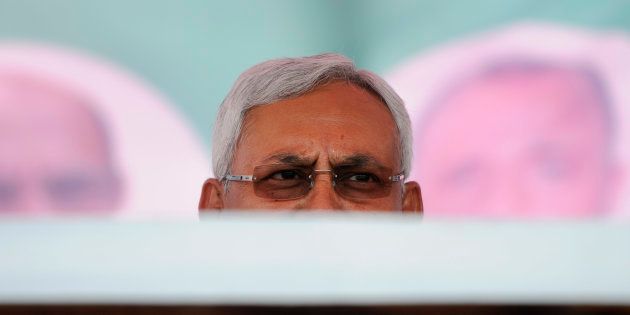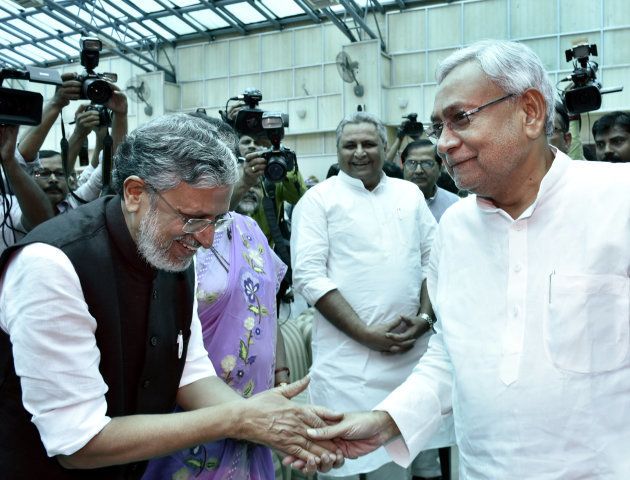
Those defending Nitish Kumar's change of alliance partner are talking about corruption. Those opposing it worry about secularism. The underlying push was neither of them. In Bihar politics, caste rules the roost.
Nitish Kumar's image as a development-oriented politician masks his primary political achievement: that of mastering caste politics. It was with smart social engineering that Kumar was able to displace the 15-year-old regime of Lalu and Rabri Yadav.
Nitish Kumar has done with caste politics what has happened nowhere else: he divided Dalits into two, creating the category of Mahadalits. He divided the OBCs into two, with the Extremely Backward Classes being his main focus for votes. He even managed to divide Muslims on the lines of caste, initiating electoral Pasmanda politics.
Nitish Kumar has done with caste politics what has happened nowhere else: he divided Dalits into two, creating the category of Mahadalits.
Caste politics played heavily on Kumar's mind in dumping Yadav and going back to his old ally, the BJP.
Kumar had been public making noises in favour of the BJP for several months, but most expected him to actually break his alliance only in 2018 or 2019, on the eve of the next general elections. This would have been in time for the 2020 Bihar assembly elections, to pre-empt Tejashwi Yadav from demanding the chief minister's chair.
If the RJD's messy corruption cases are denting Kumar's image, he also stands to lose the Muslim vote and hurt his secular credentials by going with the BJP.
If Kumar and Lalu Yadav are old foes who make awkward allies, that is also the case with Kumar and Narendra Modi.
If the RJD having more MLAs than JDU was a cause of insecurity for Kumar, allying with the aggressive BJP of Modi-Shah is fraught with danger. After all, the state of the BJP's regional allies, from Shiv Sena in Maharashtra to the PDP in Jammu & Kashmir is visible to everyone, Kumar included.
What was the great political hurry, in that case, for Kumar to join hands with the BJP?
For some time, Kumar has been telling his allies about the real threat he faces with the Lalu alliance — foregoing his deft caste arithmetic that keeps him glued to the chief minister's chair despite having only 4% population of his own caste, and a weak party structure. The Lalu alliance was threatening the very foundation of Kumar's politics.

Since Yadavs are a dominant caste, in Bihar as in UP, they tend to alienate the lower OBCs as well as Dalits with petty crime, corruption and land grab. With their own party in power, Yadavs feel emboldened to assert themselves over lower castes even more.
In recent months, Kumar is learnt to have expressed reservations about this to his aides. Having an alliance with Yadav also means that he and his party get to have a say on the appointment of DMs and SPs where Yadavs are dominant, and the RJD wins more seats. This means that Yadavs close to the RJD are able to exert influence on the district administration and get away with their domination of lower castes, often in violation of the law.
Kumar, in one of his first decisions after changing his alliance partner, ordered the transfer of 28 IAS and 44 IPS officers.
The 2015 election results themselves had given a glimpse of this. The BJP and its allies may have lost the election to the Nitish-Lalu-Congress Mahagatbandhan but it still managed to increase its vote-share from 16.4% to 24.4%. This increase was partly a reflection of the post-Modi BJP's ability to woo the EBCs.
This is also why Kumar's JDU won 71 seats as opposed to Lalu Yadav's RJD which won 80. Both had contested 101 seats each.
Nobody was surprised to see that Kumar's coming together with Yadav drove some EBCs away, given the Yadav factor. Despite the Backwards versus Forwards narrative pushed by Yadav, it wasn't easy for many to forget the 'Jungle Raj' days.
Nobody was surprised to see that Kumar's coming together with Yadav drove some EBCs away, given the Yadav factor. Despite the Backwards versus Forwards narrative pushed by Lalu Yadav, it wasn't easy for many to forget the 'Jungle Raj' days.
But matters became worse after the Mahagatbandhan came to power. Kumar felt the alliance government was making him lose EBC votes by the day, even as they were attracted to Modi's pro-poor pitch after demonetisation.
The BJP does make a more natural ally for Kumar, who is now back to his famous coalition of extremes, in which Dalits and EBCs join hands with upper castes to isolate the Muslim-Yadav formula of the RJD.